Abstract
1. The composition of the nasal salt-glands of geese was found to be Na 57 ± 3·5 (S.E.), K 52·3 ± 3·9 and Cl 78·3 ± 11·0 m-equiv/kg fresh tissue. During secretion, the Na content was significantly raised to 72·4 ± 3·4 m-equiv/kg.
2. Salt-gland slices incubated in Krebs—Henseleit bicarbonate medium plus glucose (6 mM), in the presence of [14C]sucrose as an extracellular marker had the following composition, Na 85·3 ± 3·1, K 37·1 ± 3·1 and Cl 74·3 ± 3·6 m-equiv/kg. The calculated intracellular concentrations were for Na 61·5 ± 2·1, K 105·3 ± 8·7 and Cl 37·8 ± 5·0 m-equiv/l. intracellular water.
3. Ouabain (10-4 M) significantly decreased the tissue and cell K concentration and significantly increased the Na concentration.
4. Acetylcholine (10-6 M) and eserine (10-4 M) in the incubation medium had no effect on intracellular composition.
5. Raising the Na concentration of the medium to 172 m-equiv/l. and the Cl to 156 m-equiv/l. in two experiments had no effect on the calculated intracellular composition.
6. These results do not support reports that the cells have a very high Na concentration (about 350 m-equiv/l. intracellular water). They are compatible with the hypothesis that the hypertonic secretion is formed across the luminal membrane of the secretory cell by an active Na+ pump and there are no data to suggest that Na+ is concentrated across the basal membrane by a ouabain-insensitive process.
7. The data are discussed in relation to permeability studies and to electrical potential measurements within the gland by other workers.
Full text
PDF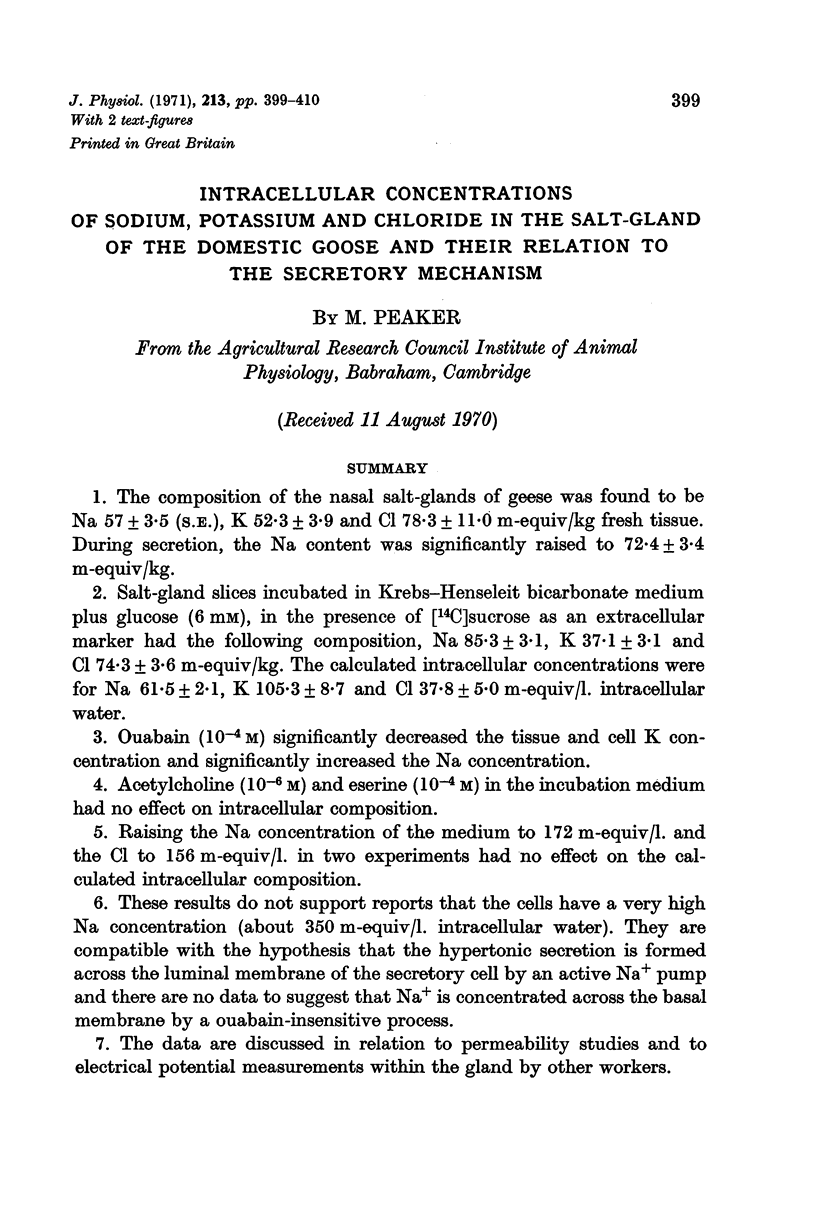
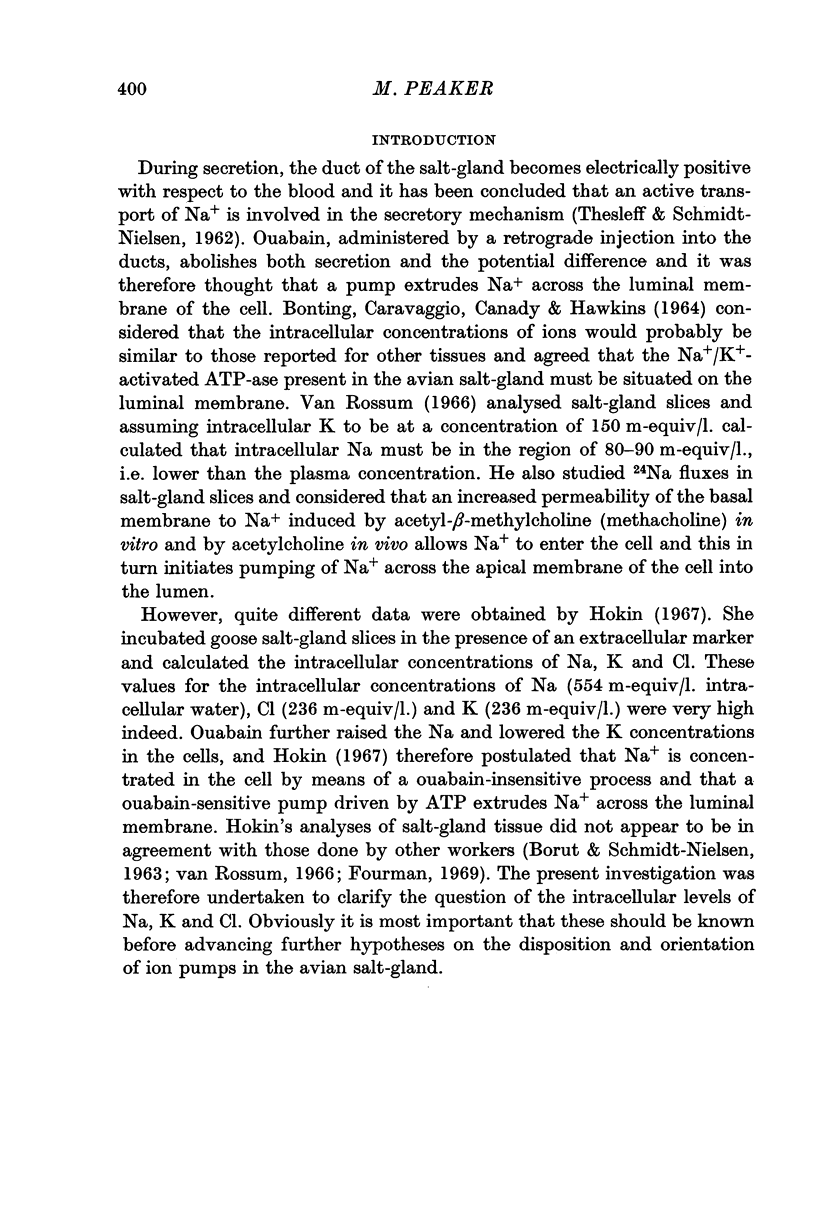
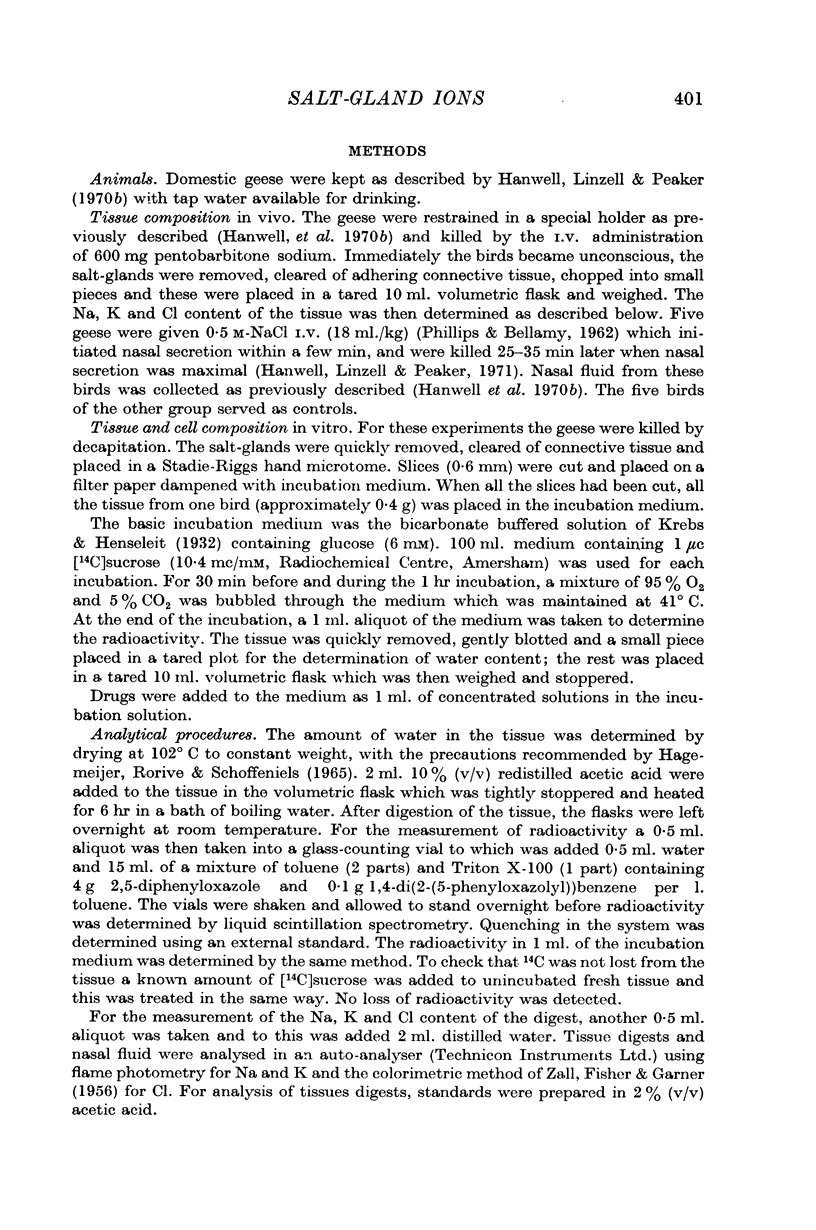
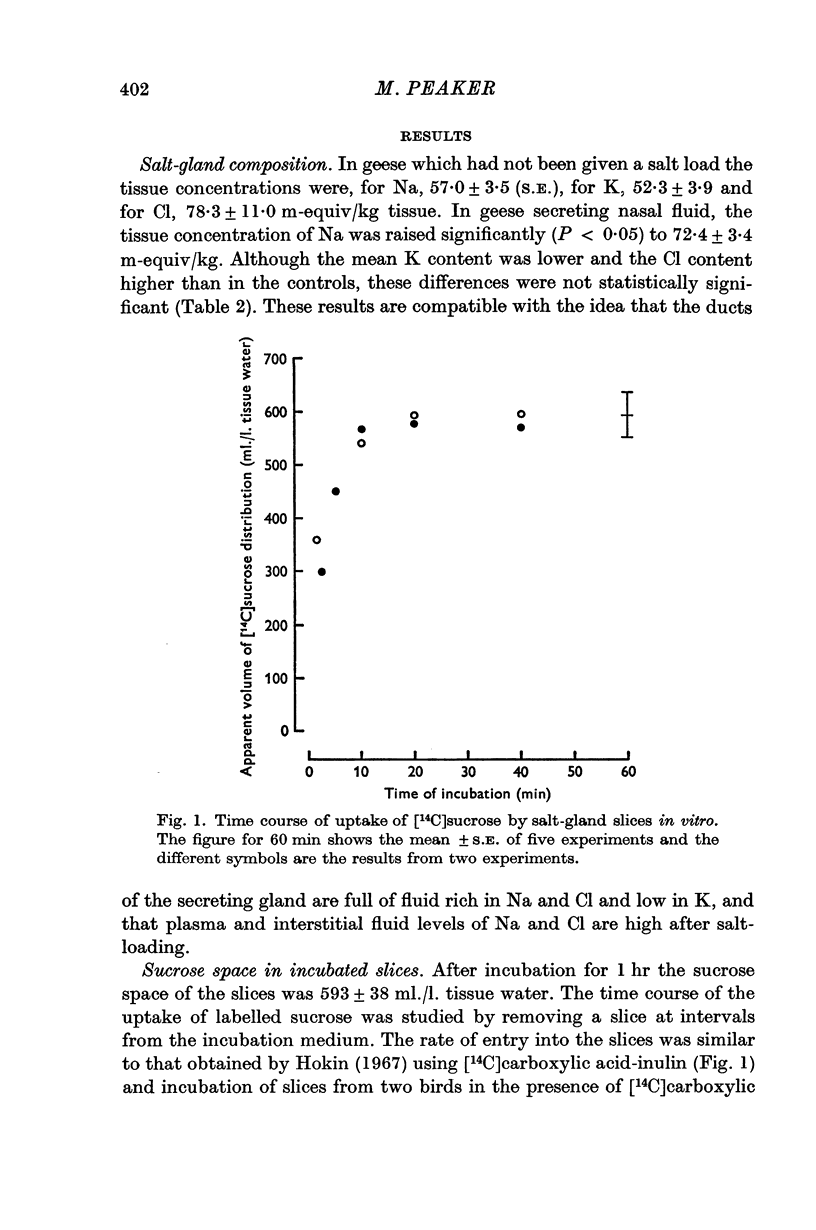
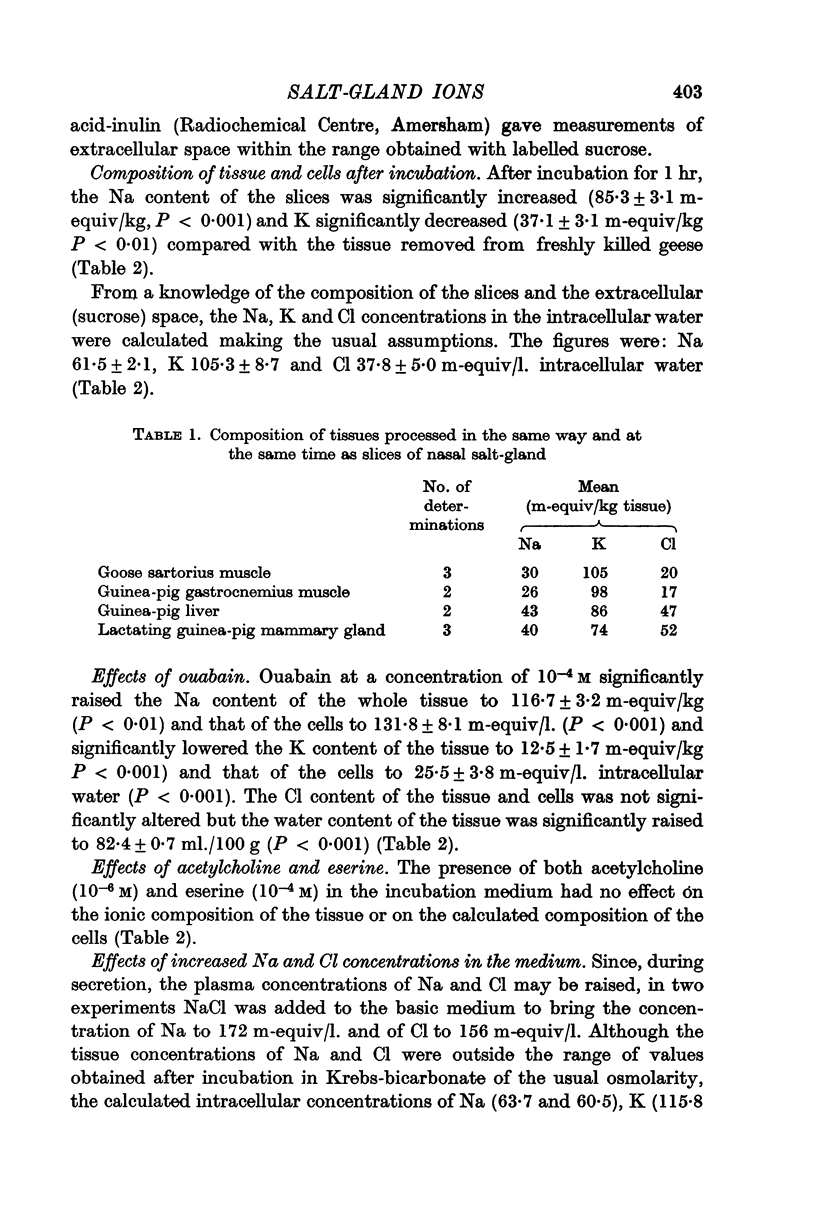
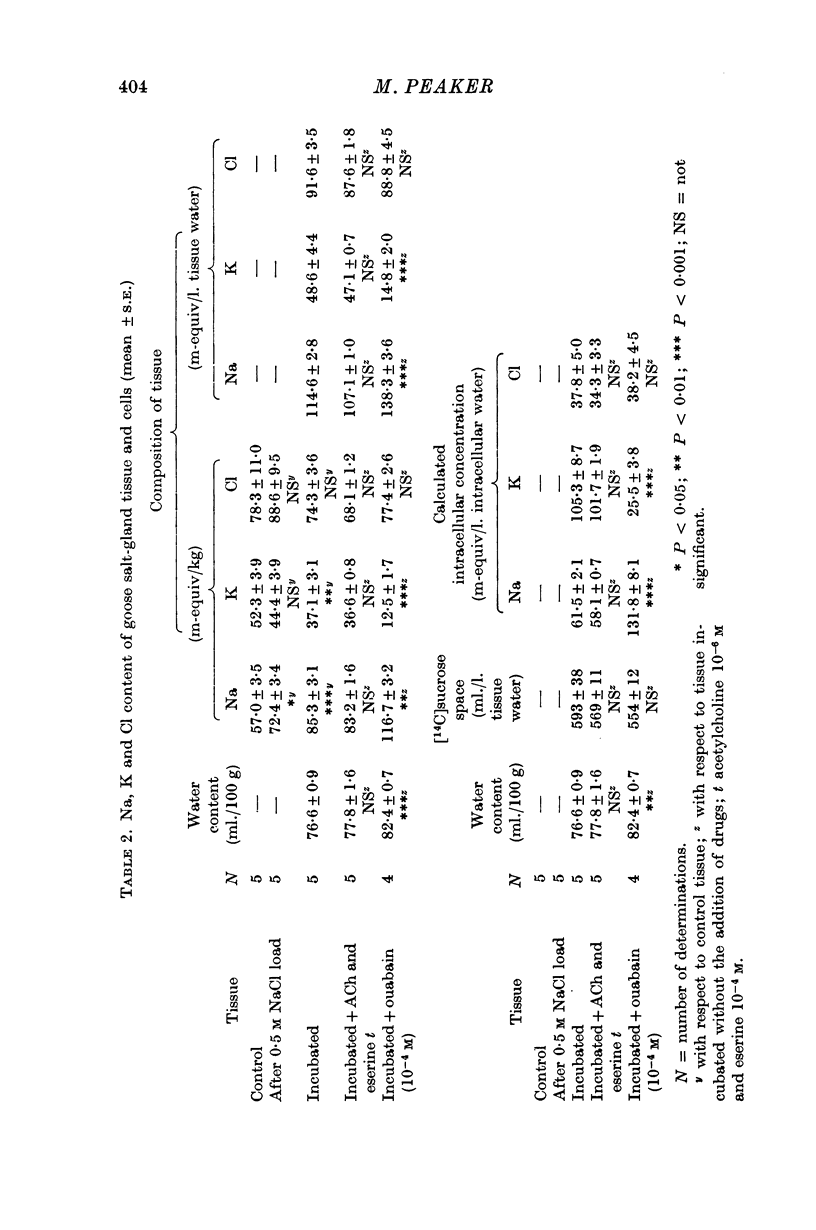
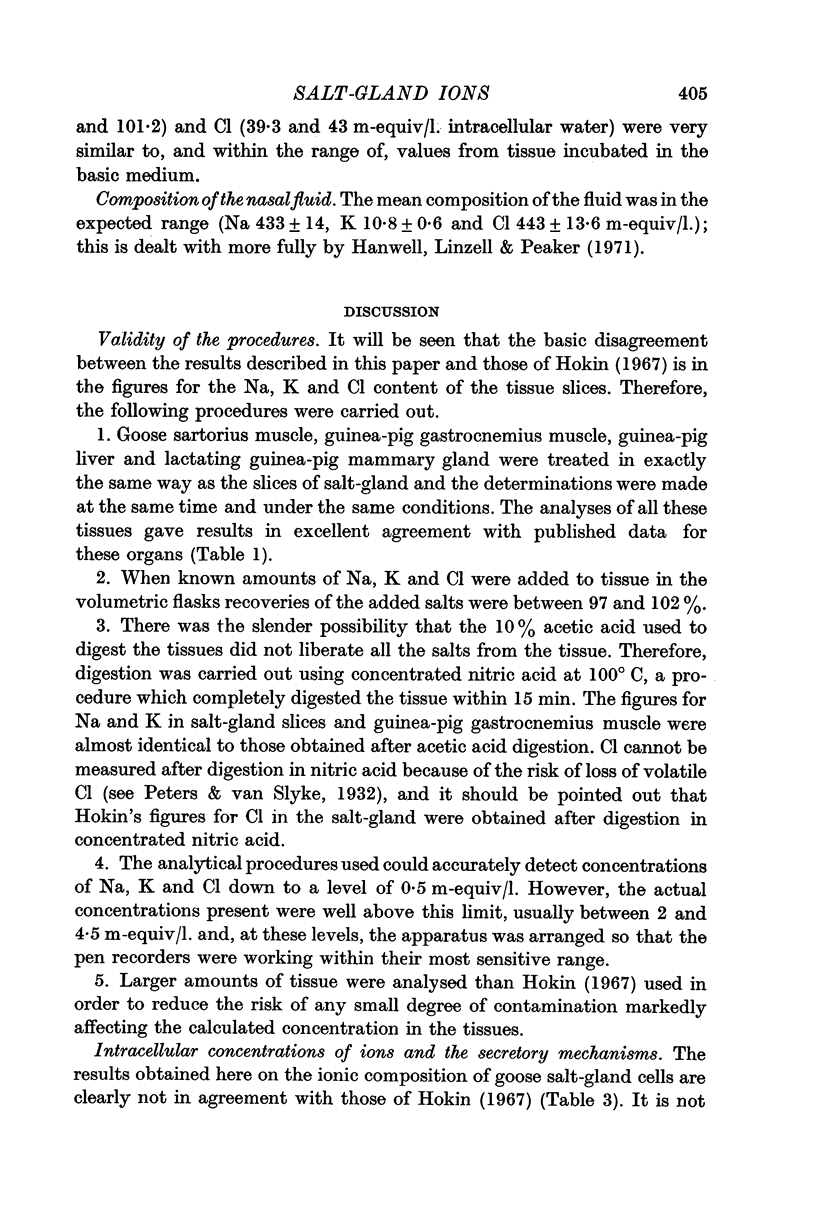
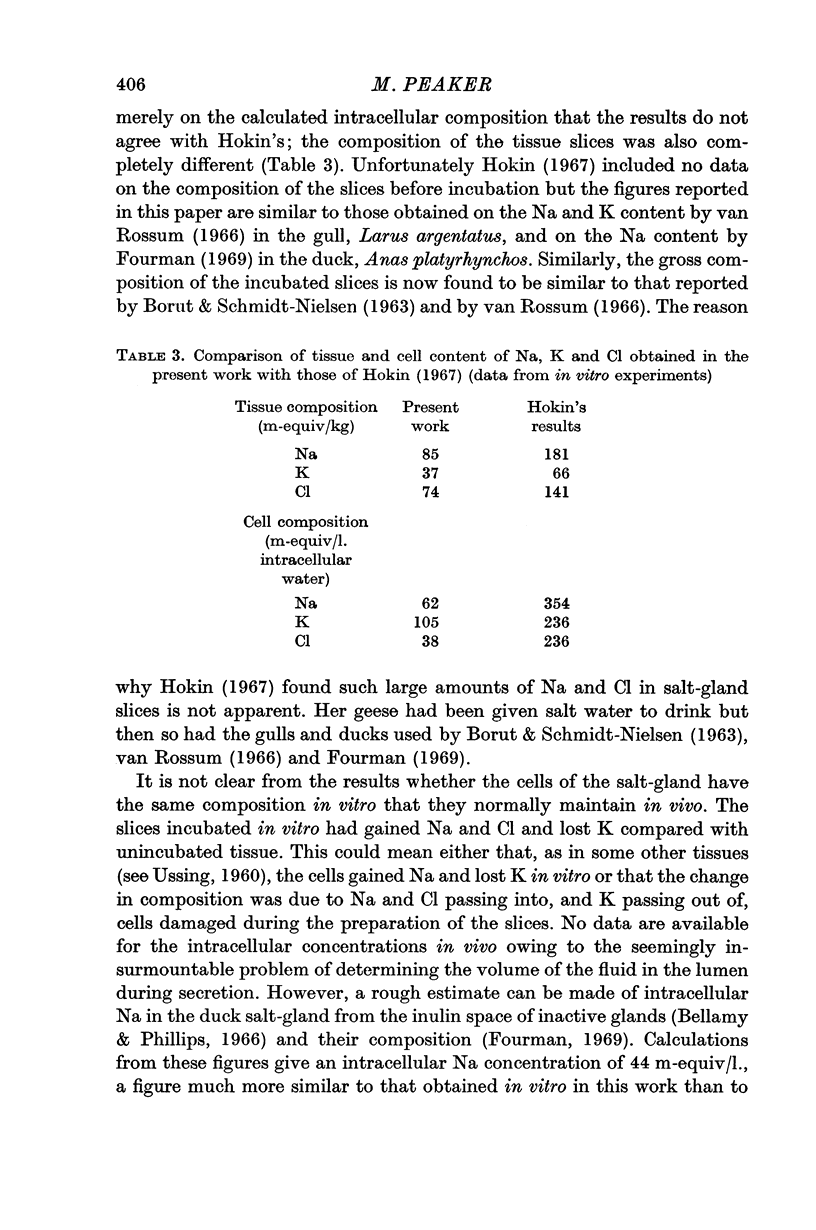
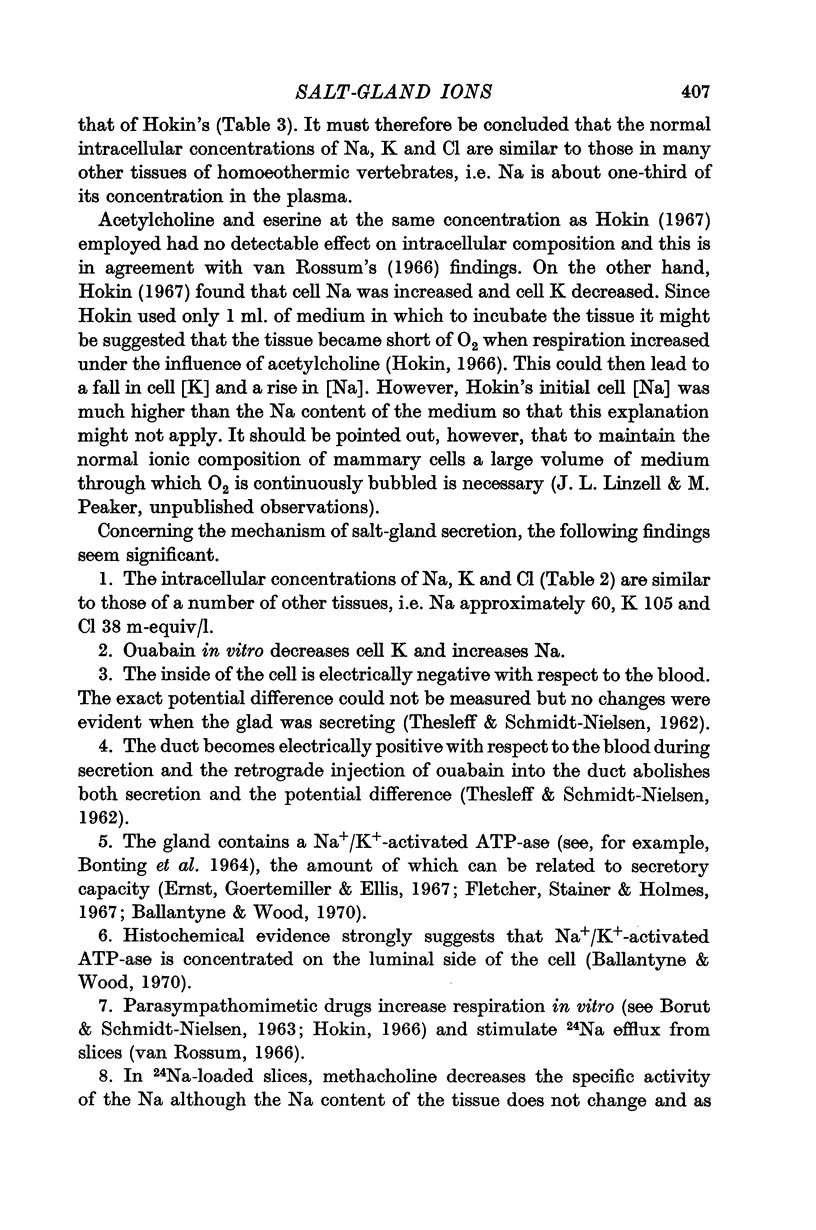
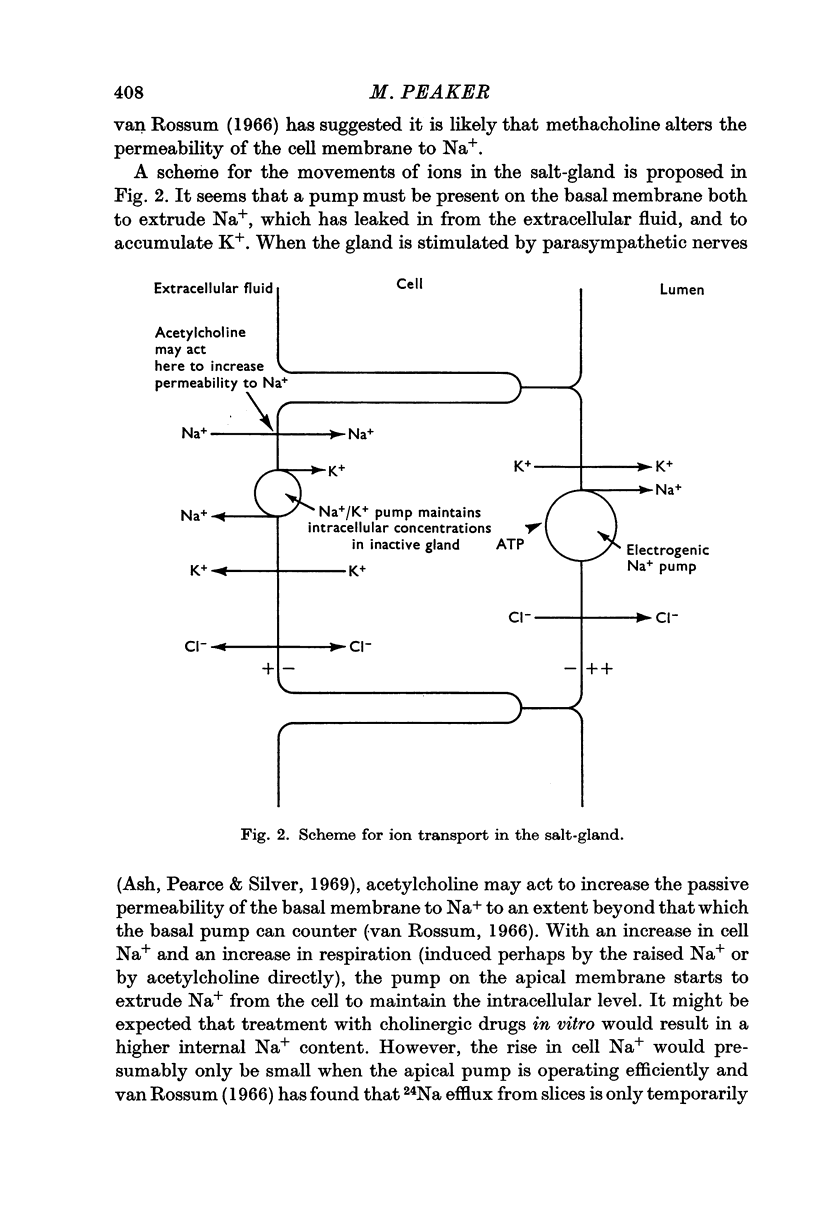
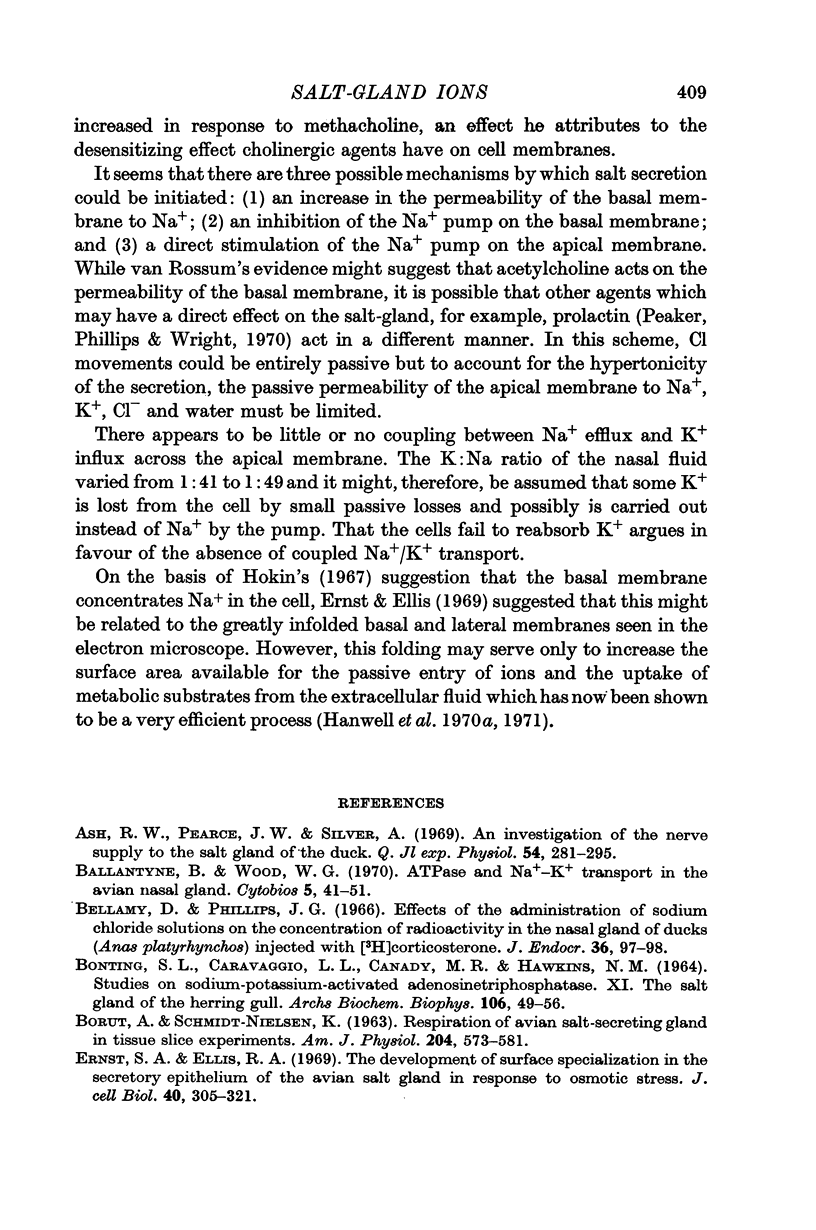
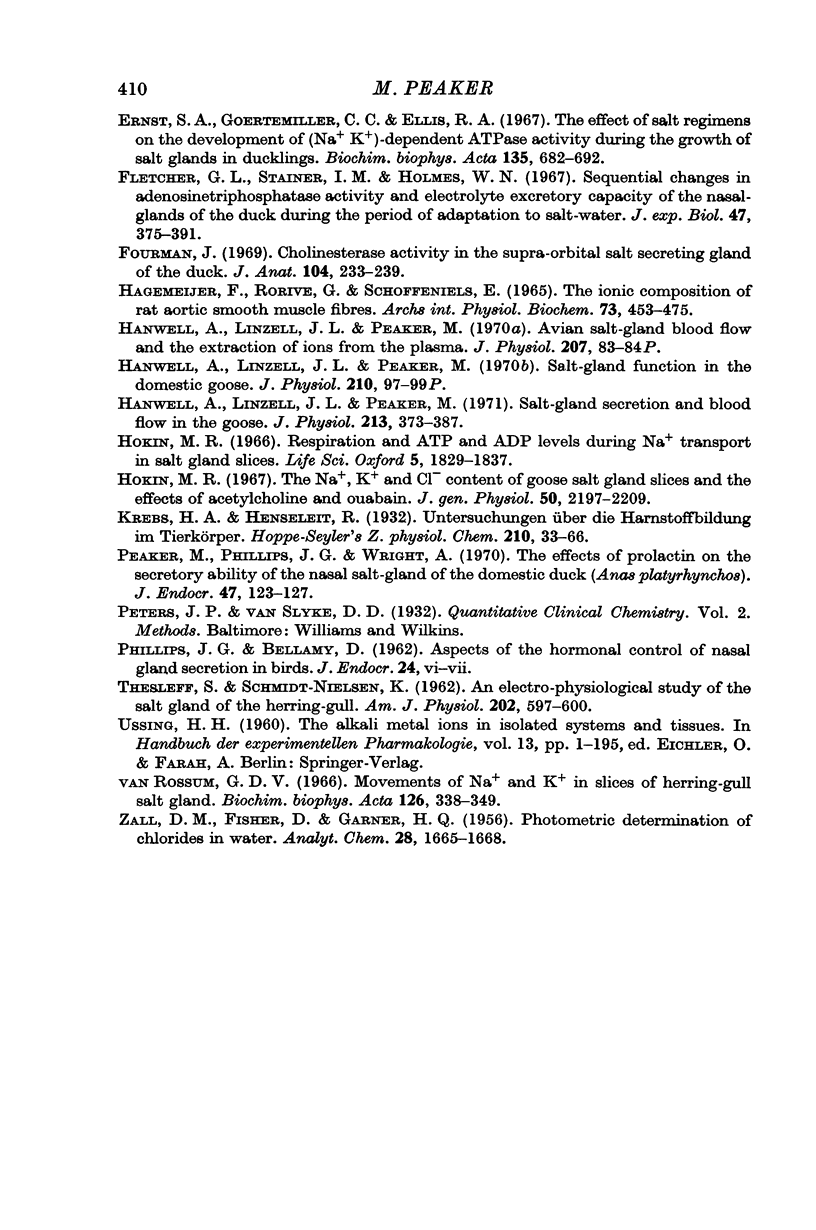
Selected References
These references are in PubMed. This may not be the complete list of references from this article.
- Ash R. W., Pearce J. W., Silver A. An investigation of the nerve supply to thealt gland of the duck. Q J Exp Physiol Cogn Med Sci. 1969 Jul;54(3):281–295. doi: 10.1113/expphysiol.1969.sp002027. [DOI] [PubMed] [Google Scholar]
- BONTING S. L., CARAVAGGIO L. L., CANADY M. R., HAWKINS N. M. STUDIES ON SODIUM-POTASSIUM-ACTIVATED ADENOSINETRIPHOSPHATASE. XI. THE SALT GLAND OF THE HERRING GULL. Arch Biochem Biophys. 1964 Jul 20;106:49–56. doi: 10.1016/0003-9861(64)90155-9. [DOI] [PubMed] [Google Scholar]
- BORUT A., SCHMIDT-NIELSEN K. Respiration of avian salt-secreting gland in tissue slice experiments. Am J Physiol. 1963 Apr;204:573–581. doi: 10.1152/ajplegacy.1963.204.4.573. [DOI] [PubMed] [Google Scholar]
- Bellamy D., Phillips J. G. Effect of the administration of sodium chloride solutions on the concentration of radioactivity in the nasal gland of ducks (Anas platyrhynchos) injected with [3H]corticosterone. J Endocrinol. 1966 Sep;36(1):97–98. doi: 10.1677/joe.0.0360097. [DOI] [PubMed] [Google Scholar]
- Ernst S. A., Ellis R. A. The development of surface specialization in the secretory epithelium of the avian salt gland in response to osmotic stress. J Cell Biol. 1969 Feb;40(2):305–321. doi: 10.1083/jcb.40.2.305. [DOI] [PMC free article] [PubMed] [Google Scholar]
- Ernst S. A., Goertemiller C. C., Jr, Ellis R. A. The effect of salt regimens on the development of (Na+K+)-dependent ATPase activity during the growth of salt glands of ducklings. Biochim Biophys Acta. 1967 Sep 9;135(4):682–692. doi: 10.1016/0005-2736(67)90098-3. [DOI] [PubMed] [Google Scholar]
- Fletcher G. L., Stainer I. M., Holmes W. N. Sequential changes in the adenosinetriphosphatase activity and the electrolyte excretory capacity of the nasal glands of the duck (Anas platyrhynchos) during the period of adaptation to hypertonic saline. J Exp Biol. 1967 Dec;47(3):375–391. doi: 10.1242/jeb.47.3.375a. [DOI] [PubMed] [Google Scholar]
- Fourman J. Cholinesterase activity in the supra-orbital salt secreting gland of the duck. J Anat. 1969 Mar;104(Pt 2):233–239. [PMC free article] [PubMed] [Google Scholar]
- Hagemeijer F., Rorive G., Schoffeniels E. The ionic composition of rat aortic smooth muscle fibres. Arch Int Physiol Biochim. 1965 Jun;73(3):453–475. doi: 10.3109/13813456509081857. [DOI] [PubMed] [Google Scholar]
- Hanwell A., Linzell J. L., Peaker M. Avian salt-gland blood flow and the extraction of ions from the llasma. J Physiol. 1970 Apr;207(2):83P–84P. [PubMed] [Google Scholar]
- Hanwell A., Linzell J. L., Peaker M. Salt-gland function in the domestic goose. J Physiol. 1970 Sep;210(2):97P–99P. [PubMed] [Google Scholar]
- Hanwell A., Linzell J. L., Peaker M. Salt-gland secretion and blood flow in the goose. J Physiol. 1971 Mar;213(2):373–387. doi: 10.1113/jphysiol.1971.sp009387. [DOI] [PMC free article] [PubMed] [Google Scholar]
- Hokin M. R. Respiration and ATP and ADP levels during Na+ transport in salt gland slices. Life Sci. 1966 Oct;5(20):1829–1837. doi: 10.1016/0024-3205(66)90277-3. [DOI] [PubMed] [Google Scholar]
- Peaker M., Phillips J. G., Wright A. The effect of prolactin on the secretory activity of the nasal salt-gland of the domestic duck (Anas platyrhynchos). J Endocrinol. 1970 May;47(1):123–127. doi: 10.1677/joe.0.0470123. [DOI] [PubMed] [Google Scholar]
- THESLEFF S., SCHMIDT-NIELSEN K. An electrophysiological study of the salt gland of the herring gull. Am J Physiol. 1962 Mar;202:597–600. doi: 10.1152/ajplegacy.1962.202.3.597. [DOI] [PubMed] [Google Scholar]


